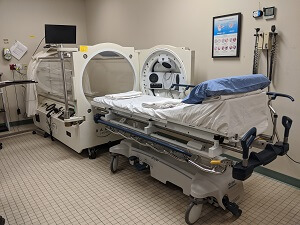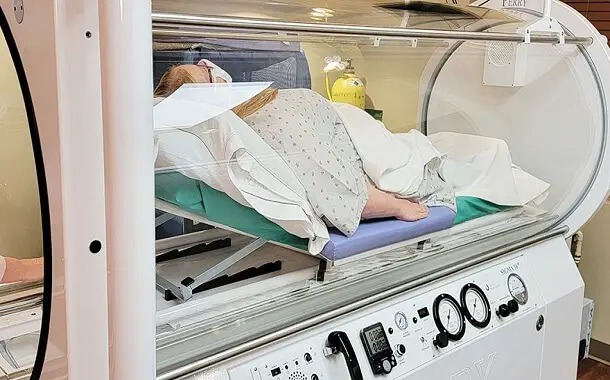How Much Does Hyperbaric Oxygen Therapy Cost?
Hyperbaric oxygen therapy (HBOT) is a type of treatment used to accelerate the healing of the body, in a special pressure chamber that increases the amount of oxygen in the blood, so that injuries heal faster and more efficiently. It can improve oxygen intake, reduce edema and stop the development of some infections.
The patient breathes pure oxygen through a special tube and mask, at air pressure levels 1.5 to 3 times higher than normal atmospheric pressure. The goal is to enrich the blood with enough oxygen to accelerate tissue repair and restore normal functions.
How Much Does Hyperbaric Oxygen Therapy Cost?
The cost of Hyperbaric oxygen therapy is anywhere between $260 and $650 per treatment if you don’t have health insurance, depending on the location of services and the number of sessions.
Factors affecting the cost of HBOT
There are several factors that will affect the patient’s out-of-pocket price of HBOT such as the severity of symptoms, the specific insurance plan, and the reason or condition for care. We will talk about each of these in the following lines.
If the condition is considered off-label or on-label
The FDA has approved the use of HBOT for several injuries and illnesses. The on-label conditions include:
- decompression sickness;
- radiation tissue damage;
- gas gangrene;
- diabetic lower extremity wounds (diabetic foot ulcers);
- non-healing wounds;
- failed skin grafts and flaps;
- central retinal artery occlusion;
- crush injury & other acute traumatic ischemias;
- smoke inhalation and carbon monoxide poisoning;
- necrotizing soft tissue infection.
In general, when a procedure is FDA-approved this is covered by the patient’s insurance.
However, the HBOT has a larger range of applications. Backed by treatment results and research, HBOT is used around the world for treating many injuries, illnesses, and conditions that are currently considered off-label in the United States of America.
Keep in mind that off-label doesn’t mean unsafe or ineffective. Every day in the United States physicians prescribe off-label many types of pharmaceutical drugs.
Location and the type of provider
 There are two main categories of HBOT providers: independent and hospital-based. The experience and cost of care for each of these may vary significantly. In general, the hospital-based HBOT programs accept most insurance. Though, they are not able to see off-label patients.
There are two main categories of HBOT providers: independent and hospital-based. The experience and cost of care for each of these may vary significantly. In general, the hospital-based HBOT programs accept most insurance. Though, they are not able to see off-label patients.
On the other hand, independent providers may see all types of patients. However, many do not accept any insurance at all. But providers like Hyperbaric Medical Solutions (HMS) do both and accept most major insurance plans, such as Workers’ Compensation, Aetna, The Empire Plan, Healthfirst, Cigna, Fidelis, Oxford/United Healthcare, Medicare, Empire Blue Cross and Blue Shield, and others.
Usually, the patients that choose the hospital-based programs, which mainly see on-label conditions, will have higher out-of-pocket costs with higher co-insurance or co-pay responsibilities than those who chose to go to independent centers and clinics such as HMS.
The prices charged by any care provider at a hospital are higher than the fees charged by your specialist’s office or primary care physician. In any situation, the out-of-pocket costs will be greatly affected by your specific insurance coverage plan.
You might also like our articles on the costs of pulmonary function tests, Cryotherapy, or wart removal.
Most probably, the off-label conditions will not be covered by insurance at all and have to be seen by an independent HBOT provider. But often financing options are available, such as CareCredit, prompt-pay discounts, and payment packages.
It is important to mention that the consultation appointments are covered by insurance.
The severity of your symptoms
The overall course of care will be affected by the severity of the symptoms. Similar to many other areas in life, the sooner a problem is addressed, the easier is to find a solution and solve it.
Most probably, your healthcare provider will recommend more HBOT sessions if you have severe symptoms like those associated with chronic conditions or brain injuries. The more treatment sessions you will need, the more you will have to pay, both through direct treatment costs and insurance co-pays/co-insurance.
What happens during hyperbaric oxygen therapy?
Only a doctor should prescribe hyperbaric oxygen therapy and make a complex assessment of the patient before entering the hyperbaric oxygen chamber. A spirometry test, an EKG, an otoscope examination, a general health consultation, identification of possible otitis, inner ear injuries, certain vascular diseases, thrombosis, and recent imaging examinations are recommended.
To benefit from hyperbaric oxygen therapy, the patient must sit relaxed, in a chair, or lie down and breathe deeply in sessions lasting up to 2 hours, following the instructions of a supervisor.
During the session, you cannot leave immediately and re-enter directly, except through the depressurization antechamber of the hyperbaric chamber where you have to spend a certain time. As a rule, electronic devices and mobile phones are not allowed, and water bottles must not be hermetically closed with a lid, because there is a risk of exploding.
The ears may feel clogged as the pressure builds, like when you’re on an airplane or in the mountains. However, simply swallowing or chewing gum can unclog the ears.
Blood carries the extra oxygen throughout the body, infusing damaged tissues that need more oxygen to begin healing. When a session is complete, you may feel dizzy. Mild side effects include claustrophobia, fatigue, nausea, vomiting, and headaches.


Leave a Reply
Want to join the discussion?Feel free to contribute!